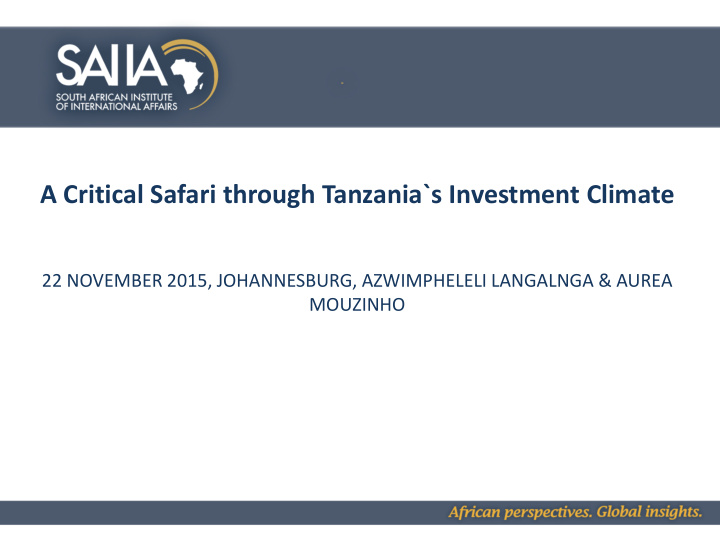



A Critical Safari through Tanzania`s Investment Climate 22 NOVEMBER 2015, JOHANNESBURG, AZWIMPHELELI LANGALNGA & AUREA MOUZINHO
OUTLINE 1. Brief Economic History of Tanzania 2. Locating Tanzania in international FDI regulation 3. Domestic regulation of foreign investments in Tanzania 4. Structural challenges to foreign investments in Tanzania 5. Towards sustainable investment 6. Recommendations and conclusions
BRIEF ECONOMIC HISTORY THREE MAIN PHASES • 1. CAPITAL ECONOMY 1961- 1967 • Characterised import substitution , public private partnerships • 2 UJAAMAA ( 1967-1983) Julius Nyerere African brand of socialism • Massive nationalisation, price controls, government subsidies and export restrictions • State owned enterprises grew from 40-425 • 3. Liberalisation Era ( 1983-current) Structural adjustment programs • Privatisation-reduction of the SOEs from 425 to current 176 • Membership to the WTO and other regional and multilateral institutions •
TZ`S FDI REGULATION World Trade Organisation TRIMS Agreement • General Agreement on Trade in Services (Mode III) • Common Market for Eastern and Southern Africa • Investment Chapter Southern African Development Community FIP • Twenty Bilateral Investment Treaties • Tanzanian Investment Act and Policies •
TZ`S OBLIGATIONS UNDER GATS/TRIMS - Tanzania has committed to commercial presence GATS - The country did not open up much of its sectors: schedule of commitments - TRIMS basically prohibits the use of performance requirements except as safeguards - COMESA had an investment chapter akin to an OECD BIT - SADC Finance and Investment Protocol (akin to BIT) - 20 BITS signed 12 in force
CROSS CUTTING PRINCIPLES - National Treatment - Most Favored Nation - Market access (via commercial presence GATS) - Fair and Equitable Treatment - Prohibition on expropriation/nationalisation - Market value compensation - International Arbitration
TZ DOMESTIC INVESTMENT POLICY - Tanzania Investment Act of 1997 - Domesticates most of the principles in the international regime - Tanzania Investment Centre ( also advises GOT on inv policy) - Tanzania Investment Regulations of 2002 (incentive scheme) - Great framework and institution but there are challenges
TRENDS 16 000 14 871.8 12 740.9 12 000 10 941.4 9 712.0 $ million 7 898.7 8 000 4 000 2 130.9 1 813.3 1 799.6 1 229.4 953.1 0 2009 2010 2011 2012 2013 Inflows Stock
Table 1: Tanzanian FDI by Sector, $ million, January 2009 – December 2013 Sectors 2009 2010 2011 2012 2013 Mining and quarrying 385.1 909.9 406.5 889.3 520.4 Manufacturing 214.5 157.1 217.3 563.7 386.6 Financial and insurance 95.9 95.5 121.1 148.1 752.2 Electricity and gas 2.1 290.5 209.4 618.3 37.3 Transportation and storage 3.9 4.0 10.4 (1.0) 19.5 Other sectors 251.7 356.2 264.9 (362.7) 414.9 Source: Tanzania Investment Commission. 2014. Tanzania Investment Report 2014 . Dar es Salaam: Bank of Tanzania, Tanzania Investment Centre, National Bureau of Statistics.
3658.8 2461.7 1834.3 1805.3 819.4 656.0 664.9 615.8 345.2 215.5 Norway USA Switzerland Netherlands Mauritius Kenya Canada Barbados UK South Africa Figure 2: Tanzanian FDI Top Ten Source Countries of FDI Stocks, $ million, 2013 Source: Tanzania Investment Commission. 2014. Tanzania Investment Report 2014 . Dar es Salaam: Bank of Tanzania, Tanzania Investment Centre, National Bureau of Statistics.
Figure 3: EAC FDI net inflows by Country, $ million, January 2005 – December 2015 2'500 2'000 $ million 1'500 1'000 500 0 2005 2006 2007 2008 2009 2010 2011 2012 2013 2014 2015 Burundi Kenya Rwanda Uganda Tanzania Data Source: World Bank. 2016. Foreign direct investment, net inflows (BoP, current US$) . Retrieved from http://data.worldbank.org/indicator on 6 September 2016.
CHALLENGES - Tanzania has a positive attitude and legislation towards FDI - Performs below EAC average in most World Bank DB indicators - Lack of infrastructure - Electricity shortages - Corruption - Land laws and tenure - Skills bottlenecks
POLICY RECOMMENDATIONS - Revision of bilateral investment treaties to allow for policy space ( use SADC Model BIT/Tz-Canada BIT) - Government assume primarily responsibility in skills dvpt - Develop SMEs with a view to linking to value chains - Linking trade and investment through a value chain oriented policy - Develop agro processing in rural areas - Engage in localisation efforts in tourism and transport
THANK YOU
Recommend
More recommend